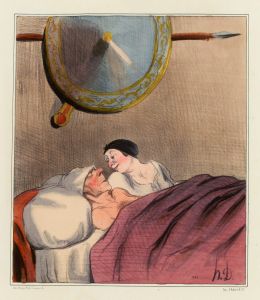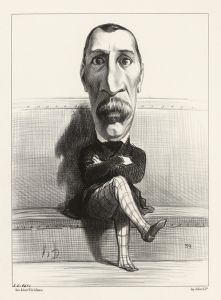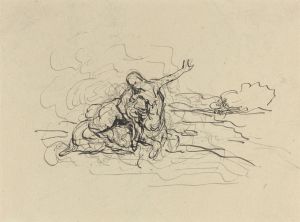
Les filets de Vulcain
A hand-painted replica of Honoré Daumier’s masterpiece Les filets de Vulcain, meticulously crafted by professional artists to capture the true essence of the original. Each piece is created with museum-quality canvas and rare mineral pigments, carefully painted by experienced artists with delicate brushstrokes and rich, layered colors to perfectly recreate the texture of the original artwork. Unlike machine-printed reproductions, this hand-painted version brings the painting to life, infused with the artist’s emotions and skill in every stroke. Whether for personal collection or home decoration, it instantly elevates the artistic atmosphere of any space.
Honoré Daumier, a French artist renowned for his satirical lithographs and paintings, created "Les filets de Vulcain" ("The Nets of Vulcan"). This artwork is part of Daumier's exploration of mythological themes, a less common subject in his oeuvre compared to his more famous political and social caricatures. The painting depicts a scene inspired by classical mythology, specifically the story of Vulcan (the Roman god of fire and craftsmanship, equivalent to the Greek Hephaestus) ensnaring his wife Venus (Aphrodite in Greek mythology) and her lover Mars (Ares in Greek mythology) in a net as a means of exposing their affair to the other gods.
Daumier's interpretation of this mythological episode reflects his characteristic style, which often combines dramatic composition with expressive figures. The painting employs a dynamic arrangement of forms and a strong use of chiaroscuro, emphasizing the tension and drama of the scene. While Daumier is primarily celebrated for his lithographs and caricatures that critique 19th-century French society, his paintings, including "Les filets de Vulcain," reveal his versatility and ability to engage with a variety of subjects.
Little is known about the specific circumstances of the creation of "Les filets de Vulcain," including its exact date of production. It is believed to have been painted during the mid-19th century, a period when Daumier occasionally turned to mythological and allegorical themes. The work demonstrates his interest in human emotion and interaction, themes that pervade much of his artistic output.
As with many of Daumier's paintings, "Les filets de Vulcain" was not widely recognized during his lifetime. His paintings were often overshadowed by his lithographic work, which gained significant attention for its biting social commentary. Today, however, Daumier's paintings are appreciated for their unique perspective and artistic merit, with "Les filets de Vulcain" standing as an example of his ability to reinterpret classical themes through his distinct lens.
The current location of "Les filets de Vulcain" is not definitively documented, and it is unclear whether the painting resides in a public collection or remains in private hands. Daumier's works are held in numerous museums worldwide, including the Musée d'Orsay in Paris and The Metropolitan Museum of Art in New York, but specific details about this particular painting's provenance and exhibition history are scarce.

















